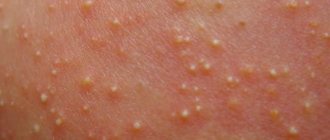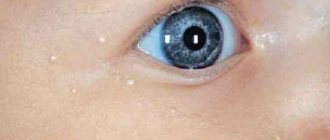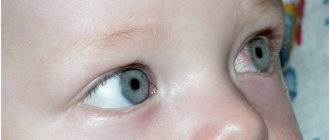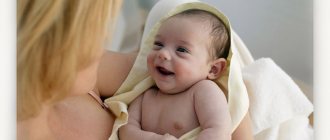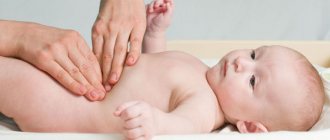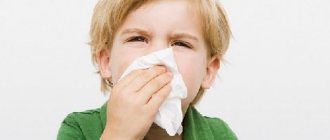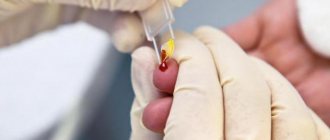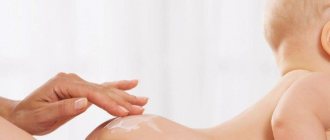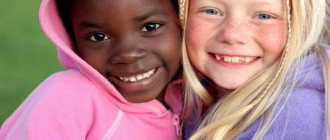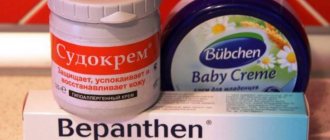The skin of newborns is very delicate; it often reacts to various negative factors with the appearance of pimples. The rash in each specific case has its own characteristics and differs in color, location and area of the affected area. The pimples themselves in newborns can be small and large, purulent and watery. There are many causes of the rash, some of them are harmless and do not require treatment, such as newborn acne, while others are a signal for immediate medical attention. Therefore, the first thing parents should do is take a good look at the rashes and the accompanying symptoms, and then try to determine why they occurred.
Rash in newborns: causes of appearance
Pimples in a newborn are divided into four main groups:
- Formation of stable hormonal levels in the baby. In this case, the rash in a baby is physiological in nature. It does not require treatment and goes away on its own after hormonal levels stabilize.
- Allergic reaction. May occur on products consumed by a nursing mother, children's cosmetics, clothing, and medications.
- Errors in child care. Allowing excess moisture on the skin leads to heat rash.
- Infectious diseases.
The rash in newborns can be in the form of blisters, pustules, white or red bumps
What types of pimples do newborns have?
There are several types of acne in infants, which will be discussed below.
- Small whiteheads (milium) appear on your baby's face, especially on the nose, in the first weeks of his life due to clogged pores. Such pimples do not cause discomfort and go away on their own after a few weeks, when the child’s sebaceous glands are fully formed.
- Yellowish-white pimples surrounded by a red ring are called erythema toxicum. Most often they appear on the body, namely on the baby’s tummy in the first week of his life. They also disappear on their own after about two weeks. The reason for the appearance of such a rash in a newborn is the secretion of a large amount of biologically active substances released during the destruction of cells that are involved in allergic reactions.
That is, it is a physiological rash, which is caused by the baby’s body adapting to new living conditions. Erythema toxicum is a fairly common rash that appears on the body in approximately 20-50% of newborns on days 2-4 of their life.
- A reddish rash that appears primarily on too wet areas of the body: in the folds of the neck, groin, behind the ears is called prickly heat. Irritated red skin feels rough to the touch. Sometimes pustules may form.
If prickly heat develops, the pimples can spread to the face. The rash appears because the child sweats a lot, for example in hot weather or if he is dressed too warmly. To prevent heat rash, you should dress your newborn in loose, lightweight clothing made from natural materials.
If prickly heat has already appeared, you can help your baby cope with it by washing his skin with cool water or a soda solution (take a teaspoon of baking soda per glass of water). You need to carefully apply a cotton wool soaked in a solution or water to the pimples, rinse lightly and then dry; do not rub the baby’s skin, because. she is very gentle. It is also recommended that your child wear diapers less often.
At about 3 weeks, the baby may develop a red, greasy rash on his face, like a teenager, and the skin on his cheeks becomes rough. Such acne appears due to the formation of hormonal levels and goes away on its own within a month and a half maximum.
- Hormonal acne in newborns usually appears on the face, and then moves to the back and neck; sometimes pimples with pustules may appear, this is normal. The main thing is not to touch or rub them, so as not to cause an infection.
Sometimes, due to the high content of hormones in the newborn’s body, sebum is produced in large quantities. It clogs the sebaceous glands, which leads to their inflammation and the formation of small nodules. Parents call such pimples baby acne, and specialists call them seborrheic dermatitis. Mostly, rashes and crusts appear on the forehead close to the hair, less often on the neck, ears, back, chest, and cheeks.
- Allergic acne is also common. The cause of their appearance is allergens contained in breast milk or formula. Therefore, mom needs to carefully monitor what she eats. When formula-fed, formula should be carefully selected.
In addition, the appearance of allergic red pimples on the body of a newborn may be associated with a reaction to external irritants, for example, washing powder, flowering plants, etc.
- Pimples can also be caused by various diseases, for example, dysbiosis, chickenpox, measles. Usually, in such cases, they are accompanied by other symptoms. With dysbacteriosis, a newborn has a tummy ache due to colic, he shows anxiety, and his bowel movements are disturbed. In any case, if the cause of the rash is not clear, you should consult a doctor.
Acne
Also in science it has the name neonatal childhood pustulosis. It consists of red or white pimples on the face of a newborn without pustules. They are located mainly on the baby’s forehead and cheeks and do not cause discomfort. This is a natural physiological process through which the baby adapts to life outside the mother’s body. There is a release of accumulated hormones that lead to the appearance of such a rash. Treatment in this case is not required; by the age of three months, such rashes go away on their own. The only requirement is to cleanse the baby's skin with boiled water or herbal decoction.
Causes
The skin of the baby is quite delicate and sensitive, easily vulnerable to any infection, the slightest impact on it of negative factors, failure to comply with maximum hygiene lead to irritation, peeling, the appearance of purulent pimples and rashes. Sometimes such rashes may indicate certain diseases in the baby’s body; sometimes they appear as a result of injury to the skin or overheating and hypothermia. In medicine, pustular disease is called “pyoderma”; most often it affects premature babies and babies with weakened immune systems. In such children, the subcutaneous fat layer is not yet sufficiently formed; the imperfect state of the epidermis and dermis contributes to the formation of wounds, which, when contaminants enter, quickly develop an inflammatory process and form an abscess.
Sometimes pyoderma can be caused by staphylococcus and streptococcus bacteria, which enter the child’s body during the first days of his life. Such ulcers are very deep, affect the ducts of the sweat glands and, as a consequence, cause furunculosis. Dysbacteriosis and intrauterine infection can also cause ulcers to appear on the face of a newborn, subsequently spreading throughout the entire body.
Food allergies
This rash on the face of a baby is usually caused by improper nutrition of the nursing mother. During breastfeeding, a woman must adhere to certain dietary rules and eat hypoallergenic foods, especially in the first months of the baby's life. Formula-fed babies may be allergic to formula components. In this case, it is recommended to replace the mixture with an alternative hypoallergenic one. The transition must be gradual; with a sudden change in baby food, allergic reactions may intensify.
Contact allergy
This type of allergy is much more common. If the baby's skin comes into contact with fabric or dishes, rashes may occur. Such pimples in a newborn may appear from a reaction to synthetic fabric, incorrectly selected washing powder or children's cosmetics. The baby's skin is extremely susceptible to chemicals and unnatural materials. Therefore, pediatricians recommend using exclusively children's care products: dishwashing liquids, washing powders and rinse aids. They contain hypoallergenic components and a minimal amount of fragrances compared to conventional products. They should be used during the baby's first year, and if he is prone to allergies, up to three years.
Milia
White pimples in a newborn may also appear due to functional problems. There is such a phenomenon - milia, which is caused by underdevelopment of the sebaceous glands. The rashes look like pearls the size of a pinhead, and the places where they appear are the same as with acne in newborns: in the area under the eyes, on the nose, cheeks, and forehead.
This type of pimples also does not require treatment: as the baby grows, his hormonal levels gradually normalize. After this, the sebaceous ducts begin to function as usual, and the rash disappears.
Diaper dermatitis
Inflamed skin in the diaper area is called diaper dermatitis. Its signs are redness of the skin, peeling and the appearance of small blisters. The disease manifests itself due to high humidity and constant contact of the skin with wet laundry. It is pointless to treat dermatitis with antihistamines. To solve the problem, you need to avoid contact of the skin with a damp environment as much as possible (timely change of the diaper). To heal the skin, there are ointments with an antiseptic effect that are ideal for young children: Bepanten, Drapolen, D-panthenol, Boro Plus.
A humid environment promotes the development of bacterial infection. If deep wounds appear, you need to be examined by a dermatologist, as a fungal infection may form, which can be treated with drugs that have a fungicidal effect.
Prickly heat
Small pink and red rash in newborns. They can appear on different parts of the child's body. Most often, pimples appear on the face of a baby, closer to the scalp. They are caused by an immature sweating system. The thermoregulation of a small organism is still imperfect, sweating occurs in large volumes, and the sweat ducts cannot remove such an amount of moisture. The result is skin rashes.
To get rid of prickly heat, you need to regularly carry out hygiene procedures and dress your child correctly in accordance with the weather. Newborns tolerate cold more easily than heat. Therefore, you should not wrap your child up, especially in the summer.
Infections
Very often, a rash in newborns is an accompaniment of some infectious disease. In addition to the face, it is localized on other parts of the body, according to the disease. In all cases of infection, the rashes are accompanied by elevated body temperature and a painful condition of the baby.
- Measles. The rash is bright red and large. Appears on the 4th-5th day of the disease. It primarily occurs on the face and in the ear area, then spreads to the entire body.
- Roseola. Red-pink rashes appear three days after infection.
- Chicken pox. The rash appears immediately along with an increase in temperature. Red watery spots all over the body.
- Rubella. Small pinkish pimples on a newborn. They appear on the face and spread to the limbs and torso.
- Scarlet fever. The scarlet fever rash begins in the neck area, gradually spreading to the back, chest, and then the whole body. It is scarlet in color and has a dotted character. If the rash appears on the face, it will not affect the nasolabial part. This is a characteristic feature of the disease.
Treatment of rashes in babies
First, you need to determine the cause of the baby's rash. If the causes are physiological, then the rash in newborns does not need to be treated. It is enough to bathe your baby every day and do not neglect hygiene procedures. If the cause is an allergic reaction of the body, remove the allergen from the diet of mother and child or change the mixture. It may be necessary to change baby care products and clothes.
When prickly heat appears, the child should be dressed according to weather conditions and avoid overheating. It will be enough to put one more layer of clothing on your child than on yourself. Give your baby air baths. When bathing, it is recommended to add decoctions of herbs or chamomile to the water. They have a beneficial effect on the skin, reducing rashes and itching. After bathing, dry problem areas using special means.
Infectious diseases are treated only by qualified doctors. At the first signs of illness, you need to call a specialist to your home.
During treatment, you need to maintain the cleanliness of things and toys that the baby comes into contact with as much as possible. It is recommended to change bed linen every day, and iron it thoroughly and on both sides. The following steps can also be used to eliminate the rash and relieve symptoms:
- bathing a child in a weak solution of potassium permanganate or herbal infusions:
- wiping problem areas with boiled water or herbal decoction three to four times a day;
- regular cleaning of the nursery and ventilation of the room in the absence of the child;
- Do not go for walks with your baby in crowded places, as his immune system is weakened.
Following these recommendations and timely seeking medical help will help you overcome the disease in a short time.
If you have a rash, you should not use colored drying antiseptics: brilliant green, potassium permanganate, fucorcin. It is prohibited to use any products that contain alcohol, as they can burn the child’s already inflamed skin. Any medicinal oils, ointments (especially hormonal ones!), creams, calendula decoction, powder can harm the baby. Taking lactic acid bacteria and sorbents like Smecta is useless. Antibiotics and drugs used during allergies should not be given to the child, they do not help.
Squeezing pimples is strictly prohibited!
Treatment of acne in children
If any type of rash or redness appears, a medical examination and examination of the baby’s body is first necessary. To diagnose the causes, blood, urine, and stool tests are taken. When a disease of the internal organs is detected, therapy is aimed at curing them. At the same time, antihistamine therapy is carried out, which reduces skin itching and prevents the appearance of ulcers and acne. The following drugs and methods are used in treatment:
- Ointment "Bepanten".
- Compliance with a diet by a nursing mother, exclusion of allergenic foods.
- Dietary food for the child, excluding foods that cause rashes.
- Treatment of acne with furatsilin solution.
- Bathing a newborn baby in a weak solution of potassium permanganate, as well as using medicinal herbs - string, calendula, chamomile, etc. The use of bathing products for adults is excluded; only children's soap and special children's sea salt are used. After bathing procedures, thoroughly rinse off any remaining foam.
- Taking antihistamines.
- If the baby is bottle-fed, replace it with a more gentle type of complementary feeding.
- For herpes, apply ice and half a tablet of paracetamol once a day. The disease lasts for several days and may be accompanied by fever. The reason is reduced immunity.
- If heat rash occurs in an infant, the humidity level in the newborn’s room should be adjusted. The room should be ventilated more often, the optimal temperature is 20-22 degrees.
- Scabies requires serious treatment. The scabies mite is contagious and can become infected by using a patient's towel or touching it. Special ointments, lotions, and solutions that have an antiparasitic effect are used. Therapy is carried out only under the supervision of a dermatologist and pediatrician.
- With eczema, the main thing is not to allow the affected areas to be scratched, otherwise infection may occur. Special ointments, solutions that moisturize and soften the skin, and antihistamines to relieve itching are used.
- For insect bites, treat the affected area with a soda solution, apply ointments, creams with an anti-allergenic effect. If the bite site is very itchy, lubricate it with brilliant green and do not allow it to be scratched to avoid infection.
- For infectious diseases, antibiotics are required.
- Vitamin therapy course.
A newborn baby may have bite marks on the neck due to mites that breed in feather pillows and blankets. Get rid of them and replace them with a set with hypoallergenic filling.
In difficult cases, when the cause of the rash is inflammatory processes in the body, hospitalization is required.
